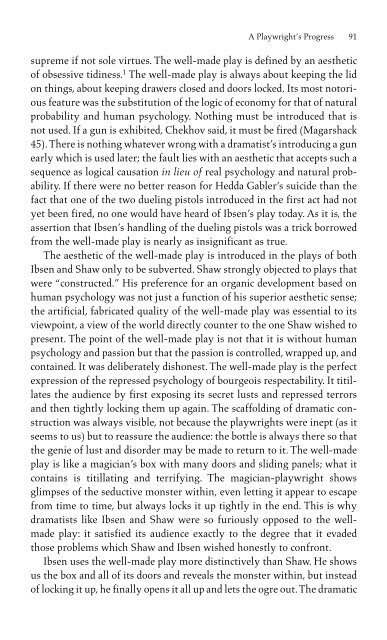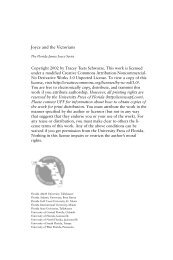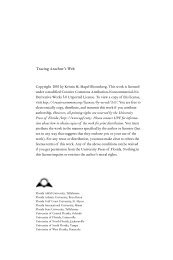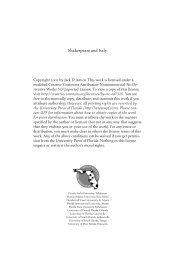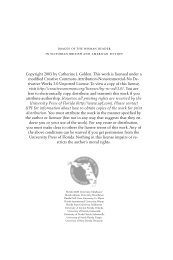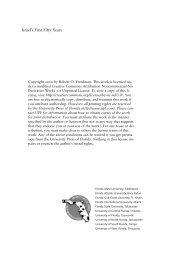Bernard Shaw's Remarkable Religion: A Faith That Fits the Facts
Bernard Shaw's Remarkable Religion: A Faith That Fits the Facts
Bernard Shaw's Remarkable Religion: A Faith That Fits the Facts
You also want an ePaper? Increase the reach of your titles
YUMPU automatically turns print PDFs into web optimized ePapers that Google loves.
A Playwright’s Progress 91<br />
supreme if not sole virtues. The well-made play is defined by an aes<strong>the</strong>tic<br />
of obsessive tidiness. 1 The well-made play is always about keeping <strong>the</strong> lid<br />
on things, about keeping drawers closed and doors locked. Its most notorious<br />
feature was <strong>the</strong> substitution of <strong>the</strong> logic of economy for that of natural<br />
probability and human psychology. Nothing must be introduced that is<br />
not used. If a gun is exhibited, Chekhov said, it must be fired (Magarshack<br />
45). There is nothing whatever wrong with a dramatist’s introducing a gun<br />
early which is used later; <strong>the</strong> fault lies with an aes<strong>the</strong>tic that accepts such a<br />
sequence as logical causation in lieu of real psychology and natural probability.<br />
If <strong>the</strong>re were no better reason for Hedda Gabler’s suicide than <strong>the</strong><br />
fact that one of <strong>the</strong> two dueling pistols introduced in <strong>the</strong> first act had not<br />
yet been fired, no one would have heard of Ibsen’s play today. As it is, <strong>the</strong><br />
assertion that Ibsen’s handling of <strong>the</strong> dueling pistols was a trick borrowed<br />
from <strong>the</strong> well-made play is nearly as insignificant as true.<br />
The aes<strong>the</strong>tic of <strong>the</strong> well-made play is introduced in <strong>the</strong> plays of both<br />
Ibsen and Shaw only to be subverted. Shaw strongly objected to plays that<br />
were “constructed.” His preference for an organic development based on<br />
human psychology was not just a function of his superior aes<strong>the</strong>tic sense;<br />
<strong>the</strong> artificial, fabricated quality of <strong>the</strong> well-made play was essential to its<br />
viewpoint, a view of <strong>the</strong> world directly counter to <strong>the</strong> one Shaw wished to<br />
present. The point of <strong>the</strong> well-made play is not that it is without human<br />
psychology and passion but that <strong>the</strong> passion is controlled, wrapped up, and<br />
contained. It was deliberately dishonest. The well-made play is <strong>the</strong> perfect<br />
expression of <strong>the</strong> repressed psychology of bourgeois respectability. It titillates<br />
<strong>the</strong> audience by first exposing its secret lusts and repressed terrors<br />
and <strong>the</strong>n tightly locking <strong>the</strong>m up again. The scaffolding of dramatic construction<br />
was always visible, not because <strong>the</strong> playwrights were inept (as it<br />
seems to us) but to reassure <strong>the</strong> audience: <strong>the</strong> bottle is always <strong>the</strong>re so that<br />
<strong>the</strong> genie of lust and disorder may be made to return to it. The well-made<br />
play is like a magician’s box with many doors and sliding panels; what it<br />
contains is titillating and terrifying. The magician-playwright shows<br />
glimpses of <strong>the</strong> seductive monster within, even letting it appear to escape<br />
from time to time, but always locks it up tightly in <strong>the</strong> end. This is why<br />
dramatists like Ibsen and Shaw were so furiously opposed to <strong>the</strong> wellmade<br />
play: it satisfied its audience exactly to <strong>the</strong> degree that it evaded<br />
those problems which Shaw and Ibsen wished honestly to confront.<br />
Ibsen uses <strong>the</strong> well-made play more distinctively than Shaw. He shows<br />
us <strong>the</strong> box and all of its doors and reveals <strong>the</strong> monster within, but instead<br />
of locking it up, he finally opens it all up and lets <strong>the</strong> ogre out. The dramatic


